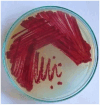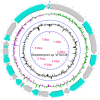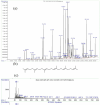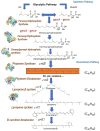Biosynthetic Pathway of psi, psi-Carotene from Streptomyces sp. VITGV38 (MCC 4869)
- PMID: 40236476
- PMCID: PMC11998277
- DOI: 10.3389/fmicb.2025.1548894
Biosynthetic Pathway of psi, psi-Carotene from Streptomyces sp. VITGV38 (MCC 4869)
Abstract
Introduction: Endophytic Streptomyces play a crucial role in plant-microbe interactions, often exhibiting beneficial biological activities, including the production of bioactive secondary metabolites. This study aimed to characterize the carotene biosynthetic pathway of a newly discovered Streptomyces sp. VITGV38, isolated from tomato (Lycopersicon esculentum).
Methods: The strain (Streptomyces sp. VITGV38, MCC4869) was cultured in starch casein broth, and its metabolite profile was analyzed using Gas Chromatography-Mass Spectrometry (GC-MS). Whole-genome sequencing was performed using the Illumina platform, and the biosynthetic gene clusters (BGCs) were identified using antiSMASH.
Results: Metabolite analysis revealed the presence of pigmented compounds, including psi, psi-carotene, detected at a retention time of 25.094, constituting 1.26% of the crude extract. Whole-genome sequencing uncovered an 8.27 Mb genome encoding 26 distinct secondary metabolite biosynthetic gene clusters. Notably, scaffold 26.3 was identified as a terpene biosynthetic cluster, accounting for 62% of the total secondary metabolite content and associated with carotenoid and β-carotene production.
Discussion: These findings highlight the biotechnological potential of Streptomyces sp. VITGV38 for sustainable microbial production of carotenoids, offering an eco-friendly alternative to synthetic pigments. This study provides valuable insights into microbial carotenoid biosynthesis and its potential industrial applications.
Keywords: Streptomyces sp. VITGV38; antiSMASH; biosynthetic gene cluster; pigment; psi; psi-carotene; secondary metabolite.
Copyright © 2025 Pattapulavar, Ramanujam, Sekaran, Chandrasekaran, Panchal and Christopher.
Conflict of interest statement
The authors declare that the research was conducted in the absence of any commercial or financial relationships that could be construed as a potential conflict of interest.
Figures









Similar articles
-
Metabolite Production and Extraction of Indole Compound From the Tomato Endophyte Streptomyces sp. VITGV100.Bio Protoc. 2025 Jul 20;15(14):e5386. doi: 10.21769/BioProtoc.5386. eCollection 2025 Jul 20. Bio Protoc. 2025. PMID: 40741389 Free PMC article.
-
Streptomyces sp. VITGV156 secondary metabolite binds pathogenic protein PBP2a and Beta-lactamase.Front Bioinform. 2025 Mar 26;5:1544800. doi: 10.3389/fbinf.2025.1544800. eCollection 2025. Front Bioinform. 2025. PMID: 40206635 Free PMC article.
-
Draft genome and secondary metabolite biosynthetic gene clusters of Streptomyces sp. strain 196.Mol Biol Rep. 2020 Sep;47(9):6741-6747. doi: 10.1007/s11033-020-05731-w. Epub 2020 Sep 4. Mol Biol Rep. 2020. PMID: 32888130
-
Synthetic Biology Tools for Novel Secondary Metabolite Discovery in Streptomyces.J Microbiol Biotechnol. 2019 May 28;29(5):667-686. doi: 10.4014/jmb.1904.04015. J Microbiol Biotechnol. 2019. PMID: 31091862 Review.
-
Mini review: Genome mining approaches for the identification of secondary metabolite biosynthetic gene clusters in Streptomyces.Comput Struct Biotechnol J. 2020 Jun 21;18:1548-1556. doi: 10.1016/j.csbj.2020.06.024. eCollection 2020. Comput Struct Biotechnol J. 2020. PMID: 32637051 Free PMC article. Review.
Cited by
-
Metabolite Production and Extraction of Indole Compound From the Tomato Endophyte Streptomyces sp. VITGV100.Bio Protoc. 2025 Jul 20;15(14):e5386. doi: 10.21769/BioProtoc.5386. eCollection 2025 Jul 20. Bio Protoc. 2025. PMID: 40741389 Free PMC article.
References
-
- Al-Dhabi N. A., Esmail G. A., Ghilan A. K. M., Arasu M. V., Duraipandiyan V., Ponmurugan K. (2020). Chemical constituents of Streptomyces sp. strain Al-Dhabi-97 isolated from the marine region of Saudi Arabia with antibacterial and anticancer properties. J. Infect. Public Health 13, 235–243. doi: 10.1016/J.JIPH.2019.09.004, PMID: - DOI - PubMed
-
- Becerril A., Álvarez S., Braña A. F., Rico S., Díaz M., Santamaría R. I., et al. . (2018). Uncovering production of specialized metabolites by Streptomyces argillaceus: activation of cryptic biosynthesis gene clusters using nutritional and genetic approaches. PLoS One 13:e0198145. doi: 10.1371/JOURNAL.PONE.0198145, PMID: - DOI - PMC - PubMed
LinkOut - more resources
Full Text Sources
Miscellaneous

